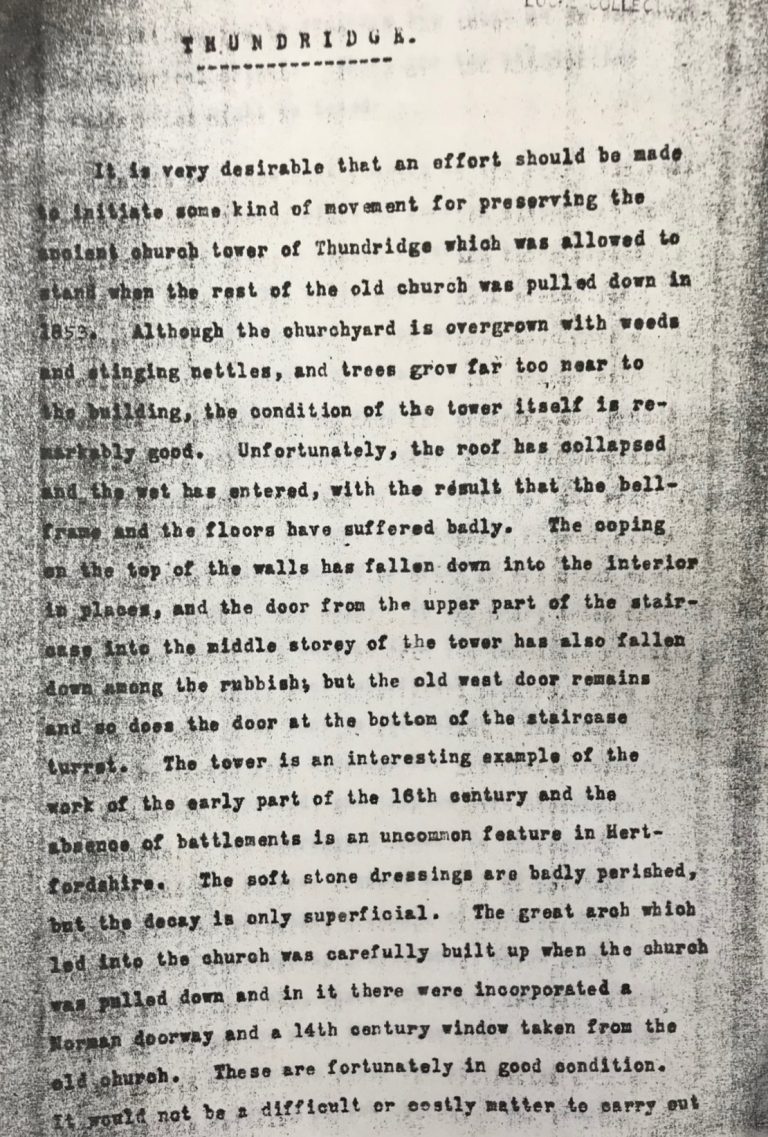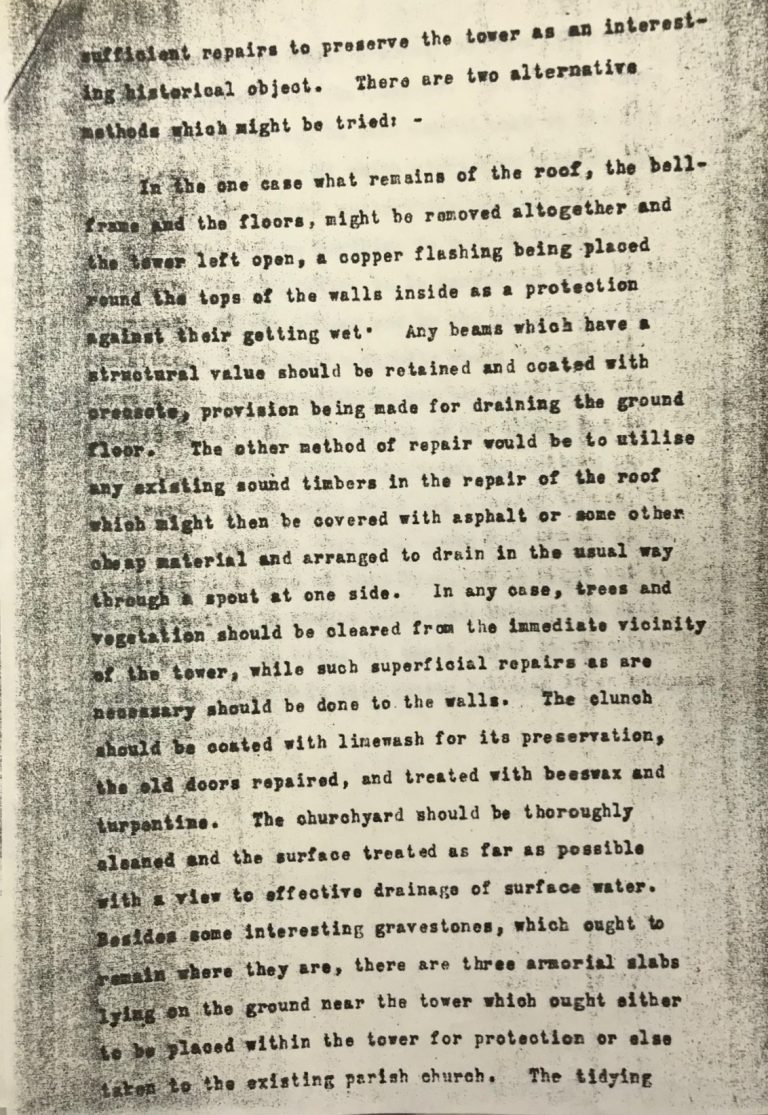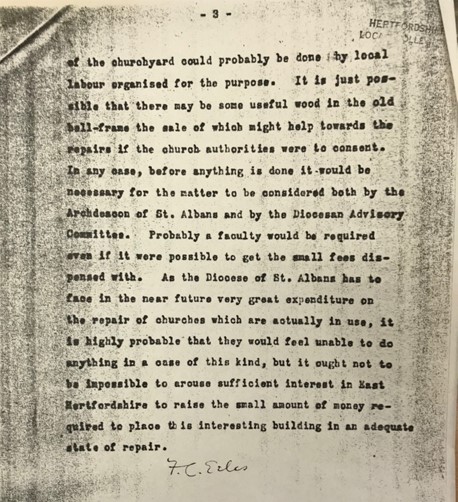It is said Robert Hanbury of Poles was dissatisfied with attending church at Thundridgebury, which had been engulfed by the Youngsbury Estate and was under the ecclesiastical control of St Mary’s, Ware.
The church needed repair. In 1841 the tower’s rubble walls had been reinforced with a pair of iron ties in the belfry and two pairs in the ringing chamber.
A structural survey by Thomas Smith in 1843, transcribed here, revealed that beams below the spire and the floors of the tower were rotten, the rubble walls were cracked in places and vibrations caused by the bells made them too unsafe to ring.
Repair costs were estimated to be £1,800, so in 1851, at a cost of £4000 Robert Hanbury commissioned the new Parish Church of St Mary’s Thundridge to be built overlooking the Rib valley on land bought from the Youngsbury estate.
The Old Church’s bells were moved to the new church and St Mary’s was consecrated on the 9th November 1853. Mr Hanbury, having severed Thundridge from the benefice of Ware St Mary’s, appointed Rev Charles Hay as the new Vicar of Thundridge. This was just as well as the warnings of poor repair were validated when a few months before opening the new church, the Nave roof of the Old Church fell in.
In March 1854 the faculty was issues giving permission for the nave and tiled chancel to be demolished. The 12th century doorway with Norman chevron moulding, and the 13th or 14th century double headed perpendicular south nave window and carved corbel heads of a medieval lady were reset in the tower’s east face. Short buttresses supporting the eastern side of the tower replaced the Saxon nave walls.
The nave’s chipped flints were allegedly re-used by Abel Smith of Woodhall in a major restoration of St Catherine’s, Sacombe in 1855-6.

Despite the demolition of the Nave and Chancel, and the migration of the congregation to St Marys, the church continued to be used for some time
As described in the ‘Posy Ring’, a dramatised but contemporary account of Thundridge published in the Hertfordshire Mercury in 1878:
“When the new site was first made use of, the old folk begged, in dying, that they might buried the place hallowed by recollections of the past, and not severed from old friends who had preceded them on journey from which no traveller returns; but this feeling soon changed to request that they might lie near to where the living assembled for weekly worship, and not be consigned to the dreary, deserted, dank, damp, and choked-up ground.”
A new toll bell specifically for use in funeral services was commissioned and installed in the tower. It was 21 inches diameter, and inscribed ‘Osborne Foundry Bishopsgate London 1853’’. It is possible this bell now hangs in gatehouse tower at Youngsbury stableyard.
Burials continued in the churchyard until 1882, despite Cussans in 1870 recording ‘the entire churchyard, and the site of the building itself, is covered with a rank and luxuriant growth of weeds and briars’
Even after burials ceased, the tower continued to be maintained and used. Articles, possibly from Parish Magazines indicate the tower had some repairs in 1891, and the sundial in 1892. Only in 1892 were the Royal Arms moved to St Mary’s where it would have been installed above the chancel arch, but now hangs, still in excellent preservation, above the entrance door from the porch.
Photographs below in the early 1900s show an intact, albeit somewhat rickety door in the Norman arch and the churchyard in reasonably good condition
A Parish magazine article in 1936 records that the Church’s pulpit and boards inscribed with the Lord’s Prayer, Creed and Commandments were still being stored in the tower and used for annual open air services.
Around the 1940s, the English liturgical scholar and ecclesiastical historian Francis Carolus Eeles (OBE) began systematically collecting details of English parish churches in order that they might be restored after wartime damage. His report tells us that despite the roof having collapsed, the bell frame and floors were still in place, albeit having ‘suffered badly’ .
The original West door, and the ancient door to the entrance of the spiral staircase were still surviving. The armorial slabs (probably Gardiner) were still intact , and recommended to be ‘placed within the tower for protection or else taken to the existing parish church’ Sadly neither happened and they are now little more than rubble.
This document is notable for its cry to preserve the tower in very similar terms to those of TOCAG over 80 years later ‘it ought not to be impossible to arouse sufficient interest in East Hertfordshire to raise the small amount of money required to place this interesting building in an adequate state of repair’.
If only it had been heeded then.



The annual open-air service was resumed in the 1960’s until at least until 1988.
In 2019 an ecumenical midsummer celebration service was held at the church, attended by 130 local people, demonstrating the support for maintaining the remains of Little St Mary’s and All Hallows’ and its unique setting. The 2020 service was regrettably postponed due to the Covid-19 pandemic; during the lockdown months, numbers passing and pausing at the quiet setting of Thundridge Old Church on permitted ‘daily exercise walks’ from Ware and surrounding villages.
